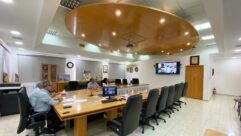
POV: The ICIA ICAT Council
Nov 1, 2004 12:00 PM,
By Joseph Bocchiaro III
When architects, facilities managers, school administrators, business owners, church pastors, and others requiring audiovisual systems in their buildings are ready to plan and design, audiovisual design consultants are prepared to help. These consultants act as client advocates, with an independent approach to systems design and equipment specification. Leading consultants and their firms are part of ICIA’s Independent Consultants in Audiovisual Technology (ICAT) Council, a talented, creative, and motivated group of professionals. The name ICAT says it all: This group is very active in the International Communications Industries Association (ICIA) and has many initiatives of interest to the audiovisual community.
Although the firms essentially compete with each other for projects, they find the time to work toward a common vision of a more professional and excellent audiovisual industry. ICAT members are primarily involved in audiovisual projects as part of a design team. The well-established consultant-led, independent, design-bid-build approach is the formula for success on countless projects around the world. Members come from a variety of fields such as electrical engineering, IT, architecture, acoustics, and programming. ICAT recognizes that there are many more professionals who still need to become a part of the group, to participate and benefit from the educational, activism, and networking opportunities. A membership criteria subcommittee within ICAT has defined the requirements and limitations for membership and reviews applications and existing members.
The ICAT Council is re-energized each year at its annual meeting at InfoComm, the ICIA tradeshow and conference. This face-to-face gathering lets members review initiatives from subcommittees, hear the latest news from ICIA staff and guest speakers, vote on various topics, and meet new members. Three other meetings are conducted by conference call each year. One important way of taking stock for the year is to participate in the Consultants’ Survey, which results in an analysis of the types of projects, types of technologies, and dollar amounts of the contracts. These studies have repeatedly shown that ICAT members are responsible for a significant amount of products specified and ultimately installed by bidding integration firms.
One of the main concerns of ICAT over the past several years is the Construction Specifications Institute’s (CSI) treatment of AV construction issues. An active committee has met to draft outlines that have been submitted to CSI for consideration. ICAT has subsequently reviewed and edited the Master Format sections pertaining to audio, video, broadcast, and AV technologies. This is a business-critical issue for ICAT because many members use CSI standards for their design packages.

The ICAT/SAVVI Forum is perhaps the most visible manifestation of the ICAT Council. Three consecutive InfoComm sessions have featured panel discussions between consultants and integrators, open to all to discuss shared issues. A more in-depth working group has sprung from this: the Best Practices ICAT/SAVVI subcommittee. This group is preparing best practices standards that define how consultants and integrators perform. The current outline from this group’s efforts is planned to result in a manual, which will be useful to new hires in consulting and integration companies. This document will also serve as a benchmark for the industry’s performance standards, visible to the architectural community and end users.
ICAT members have now met twice at the Future Summit event to discuss the future of the industry. Those brainstorming sessions have resulted in excellent dialogue. The first session, concerning AV technology, was summarized in a concise white paper, in which three years later the predictions are coming true. This year’s conclusions are being analyzed in much the same way and are focused on industry issues.
Consultants from ICAT have proven knowledgeable and reliable instructors for ICIA’s InfoComm Academy sessions. ICAT has been running a favorite course, “Working with Design Consultants,” which has continually improved during the past seven years. ICAT has also developed a course for architects that will let council members offer AIA continuing education credits outside ICIA events. ICAT members support ICIA in many other ways, such as helping promote the AVolution campaign, which is building public awareness of the AV industry. ICAT members have also participated in the ICIA iQ website, advising on the representation of AV consultants on the Web. Finally, by working as liaisons to other ICIA councils, ICAT members are able to offer a client advocacy perspective to professionals involved in other aspects of AV projects.
In the past year, ICAT has launched a new initiative to provide pro bono design and project management work to organizations serving sight- and hearing-challenged individuals. Realizing how we in the AV industry often take for granted our ability to enjoy the programming that our systems are used for, ICAT is harnessing the intelligence, influence, and observations of the council to work with worthy organizations that would benefit from AV installations. Used, new, and leftover equipment will be earmarked for these causes.
In the past, ICAT members have participated in other successful and important initiatives, such as studying the effects of Y2K on computers in AV systems, a thorough review of the ICIA CTS-D curriculum, and monitoring electrical union labor issues. You may be assured that wherever audiovisual issues of a fundamental or important nature arise, ICAT members will be involved and ready to create and respond.
Joseph Bocchiaro III, Ph.D., CTS-D, is a principal consultant with Electro-Media Design, Ltd., and manages the western New York office. He is the chair of ICIA ICAT and an adjunct faculty member of the ICIA, a member of the Association for Educational Communications and Technology, and a member of the International Association of Conference Centers. Find out more about ICAT and ICIA atwww.infocomm.org.








